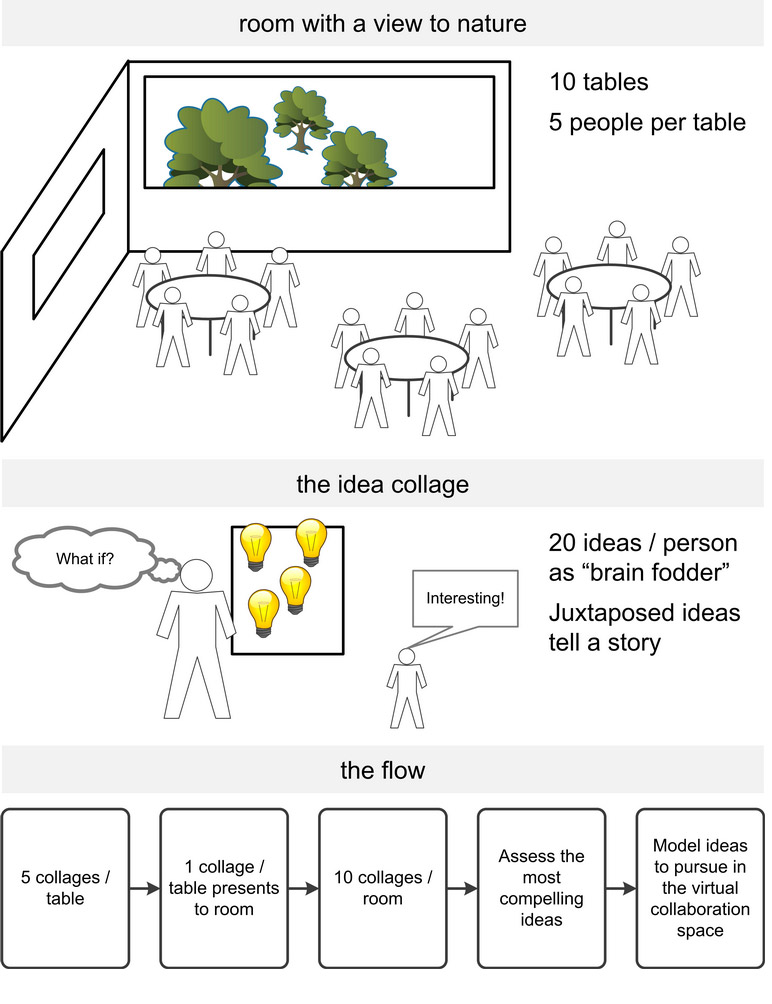By: Doug Collins
People who lead their organization’s practice of collaborative innovation find themselves on the receiving end of ideas that exist outside of their original context or charter. In this article innovation architect Doug Collins advocates that leaders embrace these orphans as a catalyst for deep, creative ideation. He lays out a way to do so by way of hosting an Ideation Scene Investigation.
Clients declare plaintively to me: “I have 500 ideas—help.”
Momentarily, they add: “And, what do I do with them?”
Orphaned ideas arrive at the innovation program’s doorstep by a number of paths. Someone—a predecessor—bequeaths them as a parting act. Someone hosts an innovation challenge. The ideas remain after the campaign team selects the ones they decide to pursue. Someone hosts an off-site brainstorm with the executive team. The ideas embody the fruits of their single day’s labor. Resuming their day jobs, nobody commits to exploring their potential.
The innovation program becomes the lost-and-found for wayward ideation.
In this light, the question of “What do I do with them?” becomes code for “How do I cut my losses, gracefully?”
I offer two responses: (1) relax, these ideas can sit for millennia—nobody will notice, and (2) now that we have relaxed, let’s not let them lie fallow. Instead, let’s have some fun by exploring their potential by applying forensic innovation.
Quincy, M.E., Revisited
Crime scene investigation shows transfix us because we love to solve puzzles. Our minds compel us to complete the picture with whatever clues avail them to us. The recent addition of high-tech forensic tools, up tempo mood music, and admirably fit actors portraying the pathologist only adds to their allure. Quincy never looked so good.
As the leader of your organization’s collaborative innovation program, you, too, have the opportunity to play a similar, if less sanguine, role.
Consider: each orphaned idea, taken out of its context, represents a piece to a puzzle the organization has yet to create. Each idea, as with each crime scene victim, has a story to tell. Here, however, the perpetrators face a shared, possibly improved future together, as opposed to hard time in the federal penitentiary.
What Do I Do with Them?
Consider the following approach by way of food for thought. I present the approach in the form of a scenario to ground the conversation in the unyielding bedrock of reality.
Imagine that, as the leader of your organization’s collaborative innovation program, you find that you own 1000 ideas out of context. Orphans. Your campaign sponsors ran challenges and decided not to pursue them. Your colleague ran an off-site brainstorm last year. Now, six months later, she e-mails you a spreadsheet of the resulting ideas in the hopes you can “do something with them.” (Thanks!) The head of the strategic IT group, in decommissioning a legacy portal, comes across a set of ideas from a long-forgotten collaboration space.
You find that, in half the cases, the people who sponsored the activity that generated the ideas no longer work for the organization. Time clouds the ideas’ lineage (figure 1).
Brilliant: absolutely brilliant. Why? As someone who dedicates themselves to the practice of collaborative innovation, you know that juxtaposing disparate ideas leads to powerful breakthroughs in creative thinking. Those ideas, cast off, represent valuable source material—brain fodder—by which your community can reframe and recast their intent to create something new.
Steve Johnson describes the power of this approach in his book, Where Good Ideas Come From.
Ideation Scene Investigation 2012
Imagine, too, that you work in an organization that employs 1000 people. (I reveal here my love of round numbers.) You assess that you can invite 50 people—5% of your population—to your inaugural event, “Ideation Scene Investigation 2012.”
By way of invitation, you observe to the 50 that (1) the organization has cultivated a rich source of ideas over the past couple years, (2) each idea represents a piece of the puzzle that, if explored together, could unlock breakthroughs, and (3) the goal of the session is, to that end, to discover what stories they, the newly minted forensic ideologists, can discern from them.
Hosts endowed with a rich sense of creativity can reference the popular crime scene shows of the day to build interest. Issue lab coats. Use your imagination (figure 2).
Structuring the Event
By way of logistics, reserve a day for Ideation Scene Investigation 2012. Reserve a room that can hold 50 people: one with windows and access to the outdoors. Have plenty of wall space to post flip charts. Array ten round tables in the room. Provide chairs for five people at each table.
The ideas serve as a starting point—inspiration—for further ideation. Providing further context works against your aims.
By way of content, randomly select and format 20 ideas for each participant. The ideas serve as their source material. People ask, “Do I need to provide deeper context for each idea?” Answer: “no.” The ideas serve as a starting point—inspiration—for further ideation. Providing further context works against your aims. Provide each participant with a flip-chart sized Post It, as well, along with scissors and tape.
By way of agenda, divide the day as follows. Start by introducing the goals for the session: creating new meaning and possibilities for ideas that their peers have contributed over the past couple years. What stories can the participants create from them?
Ask each person to take time to reflect on their 20 ideas and to share their perspectives with their table mates. Silence is optional. When ready, each participant uses tape and scissors to juxtapose the ideas in the ways that make sense to them on their flip chart page. They annotate their stories with a marker, if they choose.
Discourage idea trading at the table. Constraining participants in this way encourages their creativity, along with promoting healthy rivalry.
Allow 1-2 hours for this activity. Play Gretchen Parlato’s album, The Lost and Found, in the room to set the mood.
Next, ask each table to post their flip charts on the wall (i.e., 50 flip charts total, grouped by table). Have each person share their story with their table mates. Encourage tables to build on one another’s stories. Perhaps a primary story emerges. Regardless, ask the table to select one story to present to the larger assembly.
Give the tables a couple hours for this part of the exercise.
Break for lunch out of doors at the end of this session. Give people a chance to walk and converse in nature. Encourage them to make connections between not only the ideas but also themselves.
After lunch, reconvene the group. Assemble the ten presenters: one from each table. Ask the participants to capture two pieces of information for each presenter: (1) the degree to which they find that the idea collage depicts a potential breakthrough for the organization and (2) the degree to which they commit to developing the idea further.
Allow about 20 minutes per idea collage. Offer a break after the fifth presentation. This part of the activity will take the group to the end of the day.
Lastly, allow time for the group, as a whole, to reflect on their findings from the event. Model in your virtual collaboration space the ideas that they assess as compelling. Doing so enables the group to pursue them further, remotely and transparently (figure 3).
Parting Thoughts
You can sequence and run your own event in an infinite number of ways. Remember to (1) embrace the potential for serendipitous discovery as an important part of your practice of collaborative innovation, (2) respect the contributions of the people who first submitted the ideas, and (3) focus on helping the participants in your event derive new meaning from this valuable source material that the former provided.
The new set of ideas—reduced 200:1 from the original number in this example—becomes the next set of innovations that people can pursue as they, in their own way, realize their potential for leadership in their practice of collaborative innovation. As the leader of your organization’s collaborative innovation program, you may find that people come to anticipate your version of Ideation Scene Investigation as a popular, engaging annual event.
By Doug Collins
About the Author:
 Doug Collins is an Innovation Architect who has specialized in the fuzzy front end of innovation for over 15 years. He has served a variety of roles in helping organizations navigate the fuzzy front end by creating forums, venues, and approaches where the group can convene to explore the critical question.
Doug Collins is an Innovation Architect who has specialized in the fuzzy front end of innovation for over 15 years. He has served a variety of roles in helping organizations navigate the fuzzy front end by creating forums, venues, and approaches where the group can convene to explore the critical question.
As an author, Doug explores the critical questions relating to innovation in his book Innovation Architecture, Practical Approaches to Theory, Collaboration and Implementation. The book offers a blueprint for collaborative innovation. His bi-weekly column appears in the publication Innovation Management.



